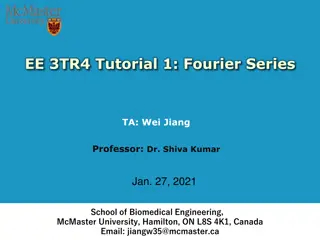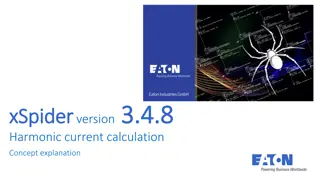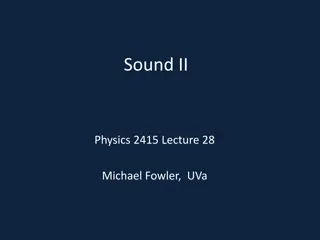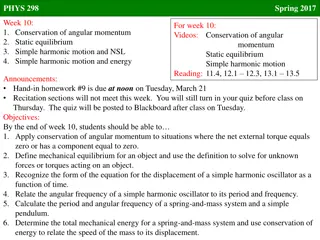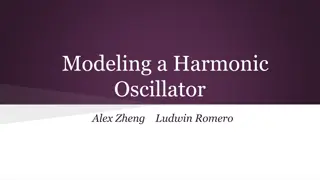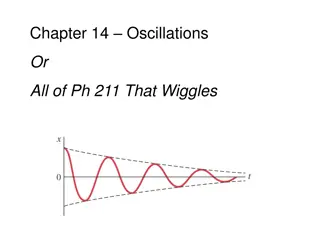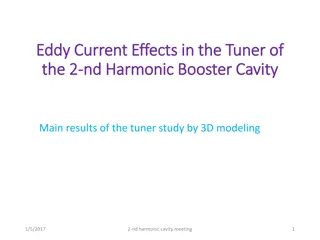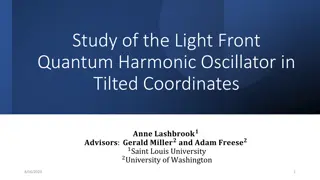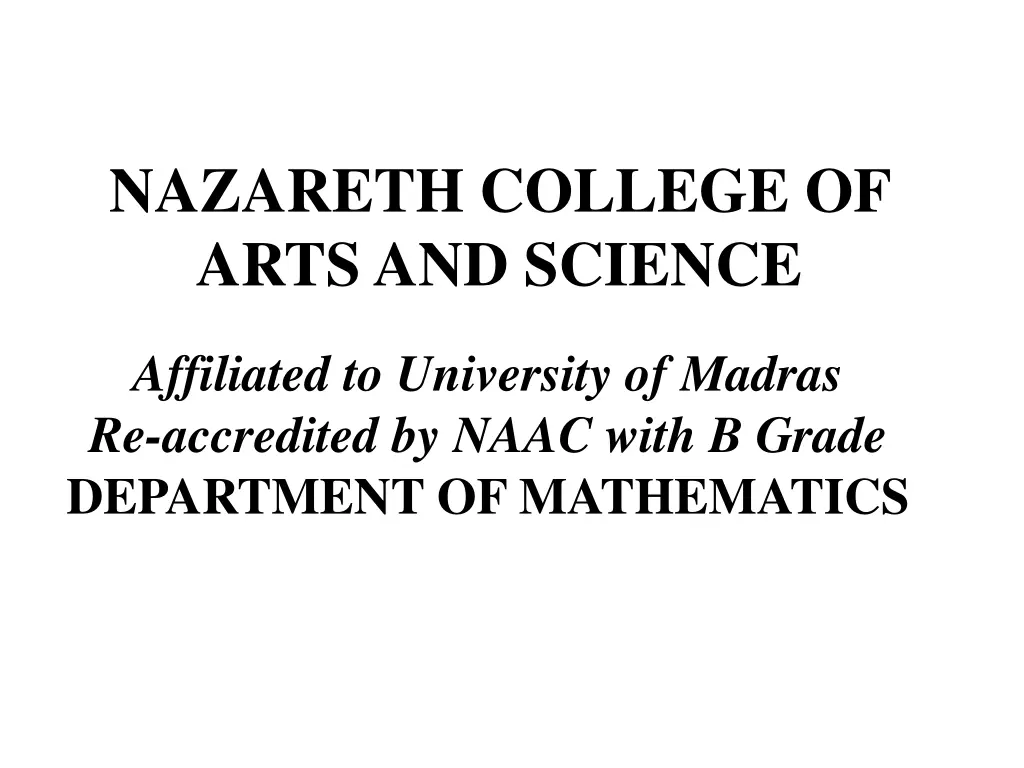
Harmonic Functions in Analytic Mathematics
Explore the fascinating world of harmonic functions in analytic mathematics, where you'll learn about derivatives of analytic functions, real and imaginary parts of analytic functions, proof of analyticity, and examples highlighting these concepts. Delve into the intricate interplay between real and imaginary components in the realm of analytic functions.
Uploaded on | 0 Views
Download Presentation

Please find below an Image/Link to download the presentation.
The content on the website is provided AS IS for your information and personal use only. It may not be sold, licensed, or shared on other websites without obtaining consent from the author. If you encounter any issues during the download, it is possible that the publisher has removed the file from their server.
You are allowed to download the files provided on this website for personal or commercial use, subject to the condition that they are used lawfully. All files are the property of their respective owners.
The content on the website is provided AS IS for your information and personal use only. It may not be sold, licensed, or shared on other websites without obtaining consent from the author.
E N D
Presentation Transcript
NAZARETH COLLEGE OF ARTS AND SCIENCE Affiliated to University of Madras Re-accredited by NAAC with B Grade DEPARTMENT OF MATHEMATICS
Academic Year: 2022 2023 Semester: Even Subject Name: Complex Analysis Class: III B.SC Maths Topic Name: Harmonic Function Name of the Faculty: D.Femila Jayaseeli
Derivatives of Analytic Function Important theorem (proven later) The derivative of an analytic function is also analytic. ( ) f z is analytic ( ) z f is analytic Hence, all derivatives of an analytic function are also analytic. ( ) z f is analytic 3
Real and Imaginary Parts of Analytic Functions Are Harmonic Functions ( ) f z ( ) ( ) = + Assume an analytic function: u x,y iv x,y ( ) ( ) 2 2 = = 0 u x,y v x,y The functions u and v are harmonic (i.e., they satisfy Laplace s equation) ( ) ( ) v z ( ) = = = = u u z u x,y Notation: ( ) v v x,y This result is extensively used in conformal mapping to solve electrostatics and other problems involving the 2D Laplace equation (discussed later). Pierre-Simon Laplace 4
Real and Imaginary Parts of Analytic Functions Are Harmonic Functions (cont.) Proof f is analytic df / dzis also analytic (see slide 23) df dz u x f v x v y u y ( ) ( ) ( ) ( ) = + = = + Notation Analytic : f z u x,y iv x,y i i ( ) z + Denote U iV u x v y v x u y ( ) ( ) ( ) z ( ) = = = = = We have: Re ; U x,y f i V x,y i i ( ) z Apply the C.R. conditions to : f 2 2 U x V y u u 2 = 0 u = = 2 2 x y 2 2 V x U y v v 2 = 0 v = = 2 2 x y 5
Real and Imaginary Parts of Analytic Functions Are Harmonic Functions (cont.) ( ) f z 2 = = Example: w z ( ) ( ) ( ) 2 2 2 = + = + = + 2 w u iv x iy x y i xy ( ( ) ) 2 2 = u x,y x y = 2 v x,y xy 2 2 2 2 u u v v 2 2 = + = = = + = + = 2 2 0 u 0 0 0 v 2 2 2 2 x y x y 6
Real and Imaginary Parts of Analytic Functions Are Harmonic Functions (cont.) ( ) f z ( ) z = = sin w Example: ( ) = + = x iy + = y i + sin sin cosh x cos sinh x w u iv y ( ( ) ) = , sin cosh x u x y y = , cos sinh x v x y y 2 2 u u = + = + = 2 sin cosh x sin cosh x 0 u y y 2 2 x y 2 2 v v = + = + = 2 cos sinh x cos sinh x 0 v y y 2 2 x y 7
Real and Imaginary Parts of Analytic Functions Are Harmonic Functions ( ) f z ( ) ( ) = + Assume an analytic function: u x,y iv x,y ( ) ( ) 2 2 = = 0 u x,y v x,y The functions u and v are harmonic (i.e., they satisfy Laplace s equation) ( ) ( ) v z ( ) = = = = u u z u x,y Notation: ( ) v v x,y This result is extensively used in conformal mapping to solve electrostatics and other problems involving the 2D Laplace equation (discussed later). Pierre-Simon Laplace 8
Real and Imaginary Parts of Analytic Functions Are Harmonic Functions (cont.) Proof f is analytic df / dzis also analytic (see slide 23) df dz u x f v x v y u y ( ) ( ) ( ) ( ) = + = = + Notation Analytic : f z u x,y iv x,y i i ( ) z + Denote U iV u x v y v x u y ( ) ( ) ( ) z ( ) = = = = = We have: Re ; U x,y f i V x,y i i ( ) z Apply the C.R. conditions to : f 2 2 U x V y u u 2 = 0 u = = 2 2 x y 2 2 V x U y v v 2 = 0 v = = 2 2 x y 9
Real and Imaginary Parts of Analytic Functions Are Harmonic Functions (cont.) ( ) f z 2 = = Example: w z ( ) ( ) ( ) 2 2 2 = + = + = + 2 w u iv x iy x y i xy ( ( ) ) 2 2 = u x,y x y = 2 v x,y xy 2 2 2 2 u u v v 2 2 = + = = = + = + = 2 2 0 u 0 0 0 v 2 2 2 2 x y x y 10
Real and Imaginary Parts of Analytic Functions Are Harmonic Functions (cont.) ( ) f z ( ) z = = sin w Example: ( ) = + = x iy + = y i + sin sin cosh x cos sinh x w u iv y ( ( ) ) = , sin cosh x u x y y = , cos sinh x v x y y 2 2 u u = + = + = 2 sin cosh x sin cosh x 0 u y y 2 2 x y 2 2 v v = + = + = 2 cos sinh x cos sinh x 0 v y y 2 2 x y 11





